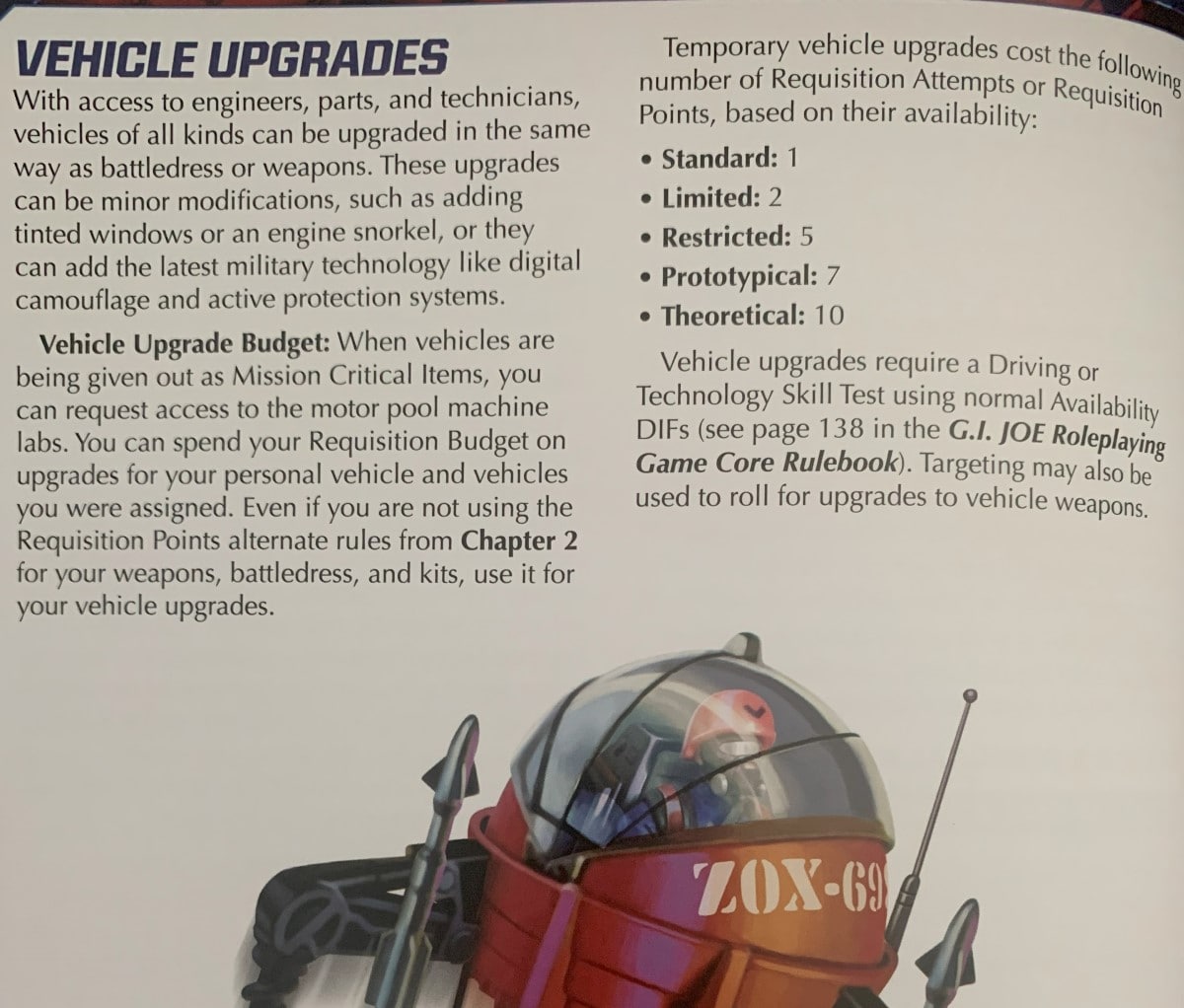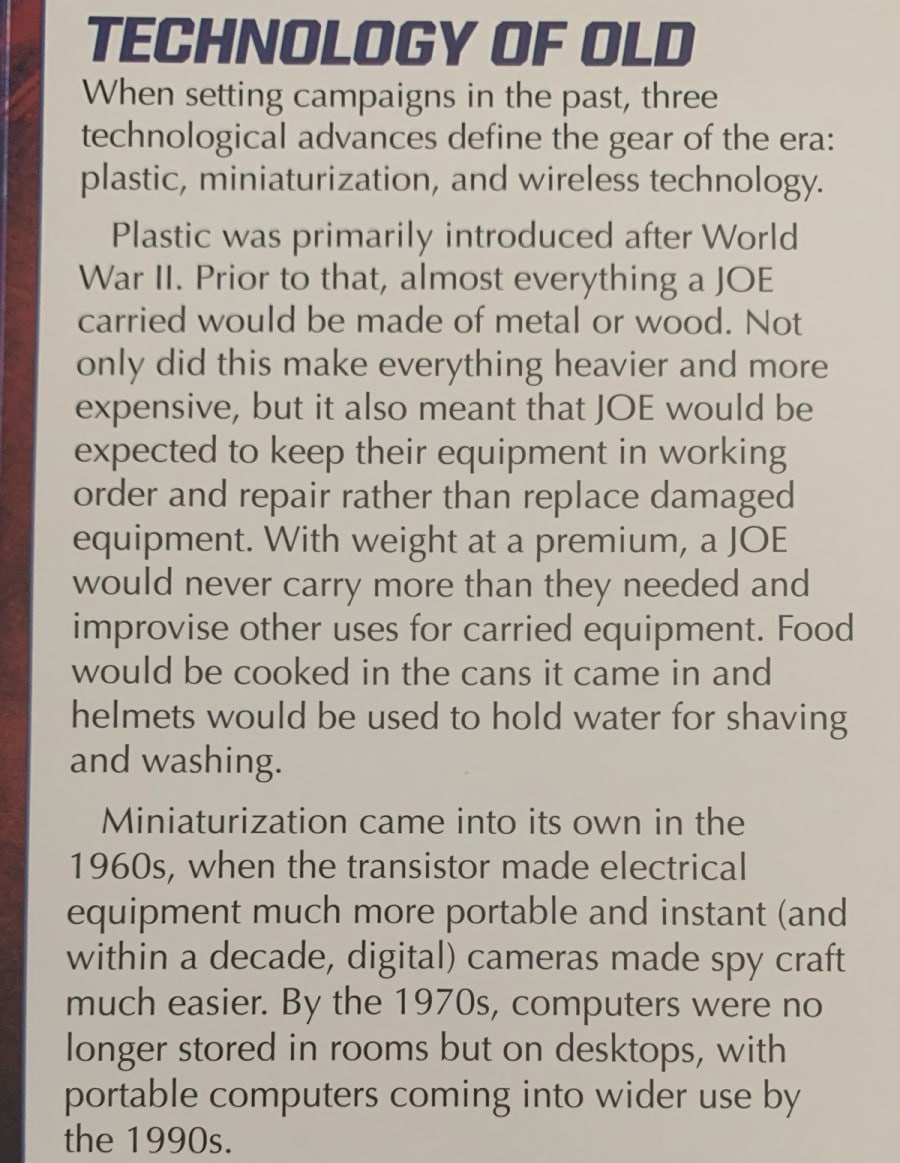When it comes to beloved toy properties, GI Joe is synonymous with vehicles and tools. It is inextricable from the series' military fantasy roots. The right men with the right tools at the right place ready to stop evil. To that end, GI Joe Quartermaster's Guide to Gear is a natural sourcebook for the franchise's RPG outing.
This book is a decent supplement given its small page count. It provides new player options and a solid swathe of GM tools, covering larger-scale campaigns. While some of those rules are given more attention than others, the book as a whole is essential if you want to get more out of your games.

What is GI Joe Quartermaster's Guide to Gear?
Gi Joe Quartermaster's Guide to Gear is 127-page Essence20 supplement for the GI Joe Roleplaying Game. It contains new player options, including new Origins, Influences, and Role Focuses for both Joe and Cobra PCs. It also contains brand new weapons, weapon upgrades, and vehicles pulled from across the franchise's history.
Lastly, it contains helpful GM rules and resources, including alternate rules for equipment requisition, setting campaigns in different time periods, as well as optional rules for vehicle-focused scenarios.

What New Equipment Options Are Introduced in GI Joe Quartermaster's Guide to Gear?
Out of GI Joe Quartermaster's Guide to Gear's five chapters, two of them are completely dedicated to new gear and vehicles.
In keeping with GI Joe'e army aesthetic, these weapons and gear upgrades are a blend of plausible military kit and sci-fi weirdness. There are rules for strobe attachments, ergonomic grips, and concealed weapons for covert ops. Upgrades that sit alongside stats for piezoelectric explosives, molecular reducers/enlargers, and (no, really) the mythical sword Excalibur.
As for defensive options, this supplement introduces a new battledress option: body armor. Functionally, body armor provides temporary health for your character. Given that Essence20 is a low-health system, that extra point of health can mean the difference between victory and defeat.
What makes body armor even better is that it can complement any player loadout. Any PC can take and equip two forms of battledress as long as one is body armor. Better still, body armor has dedicated traits and equipment. Kevlar vests, thick leather jackets, even complex bodysuits made of experimental supermetals are all available.

What New Player Options are in GI Joe Quartermaster's Guide to Gear?
In keeping with GI Joe Quartermaster's Guide To Gear's emphasis on equipment, the new player options are tech-centric. The Leadfoot Influence gives you bonuses in high-speed vehicle chases. The Futurist Origin provides free equipment for you and your squad and lower high-end gear requisition skill tests. The general perk Destructive Overcharge lets you turn certain weapons and kits into ad-hoc explosives.
But the biggest tech influence comes from the new Role Focuses. The Chameleonite Commando uses nanotech to change their appearance, making them master infiltrators. Drone Pilot Infantry gets a drone that increases utility and power with the player. Tech Officers are experts at coordinating team tactics with on the field tech savvy. Notably, they can treat Driving and Targeting skills as Smarts and Speed Essence skills. Disruptor Rangers are master saboteurs and survivalists, capable of exploiting gaps in enemy battlements. Freebooter Renegades are modern-day pirates and privateers. Highly situational, but devastating on their home turf.
Neutralizer Technicians are battlefield hackers, capable of disrupting important tech and rapidly disassembling complex electronics. Lastly, Strafer Vanguards combine their powerful defensive shields with low-altitude air support.
Generally, if you know your campaign is going for a technothriller vibe, these Role Focuses are a perfect fit.

What New GM Tools Are In GI Joe Quartermaster's Guide to Gear?
The GI Joe Roleplaying Game's gear requisition mechanic is a wonderful translation of characters getting ready for a mission. Assessing what will be necessary, planning ahead with some general tools, or requesting something disruptive or explosive just in case. It is James Bond getting gadgets from Q or the Mission Impossible crew planning a heist in TTRPG form.
As it stands in the core rules, it can be limiting for GMs. As exciting as missions and campaigns can be, the system falls into familiar beats. Briefing, exposition, make requisition skill tests, deploy, play out mission. What if players deploy deep behind enemy lines, scrounging for equipment Metal Gear-style? What if players want to upgrade their tools, making their kit an extension of their character?
GI Joe Quartermaster's Guide to Gear provides these alternative rules and more. There are rules for swapping out requisition skill tests for a requisition budget, letting players buy gear for a mission. There are rules for equipment requisition by division. Is your character's service background in Demolitions? You automatically get certain weapons, consumables, kits and battledress associated with that skillset.
The most mechanically dense is the Metal Gear-esque long-term deployment rules. They include charts and skill tests for scavenging and repairing gear based on size and time constraints.
Overall, these new requisition rules are great. They can help either speed up or add extra granularity to certain missions and campaigns as well as limit or expand player options. Want to do a GI Joe take on The Great Escape or A Bridge Too Far? The tools are here.
As for new vehicle combat rules, they are light but effective. These range from accounting for 3D vehicle movement to adjusting battlemap size for vehicle-focused encounters. One of these variant rules I find most creative is Group Specialization Tests. If a team is all manning a vehicle and want to perform a complex maneuver that uses different skills, the driver rolls a D20 and the teammates roll their respective skill dice, treating the entire test as a specialized roll.

The biggest idea in GI Joe Quartermaster's Guide to Gear is the chapter dedicated to different time periods. Mechanically, it may be the most threadbare section of the book. It discusses historical technological advancement but provides few suggestions for how that tech can be expressed in-game.
The research cited is all compelling, and the book addresses potential changes to the contents of field kits and battledress. Just don't expect transformative charts and rules if you're planning on having the Joes and Cobra duke it out in WW1 or the Cold War.
But if you're a fan of far-future adventures, the supplement has you covered. There are rules and suggestions for cybernetic enhancements and nanomite infusion powers. These range from technoswarms that can disintegrate objects to active combat and defense bonuses. There are even futuristic Threats in the chapter, all of which illustrate how dangerous nanotech can be.

Should I Pick Up GI Joe Quartermaster's Guide To Gear?
While it is low on pages and uneven with its content, GI Joe Quartermaster's Guide To Gear is a solid supplement. It streamlines and expands some of the game's more complex rules while giving players and GMs plenty of material.
The copy of GI Joe Quartermaster's Guide To Gear used in this review was provided by the publisher. All screenshots were taken during the process of review.
Review Summary
Pros
- Creative Role Focus Options
- Robust Battledress and Vehicle Upgrade Options
- Great Alternative Vehicle Combat Rules
Cons
- Uneven Historical Period Rules
- Limited Page Count
Have a tip, or want to point out something we missed? Leave a Comment or e-mail us at tips@techraptor.net












